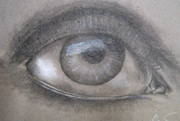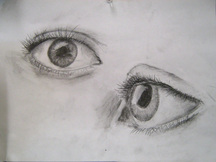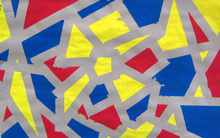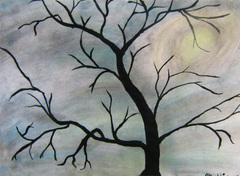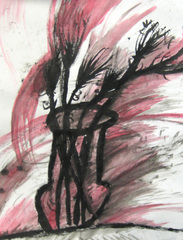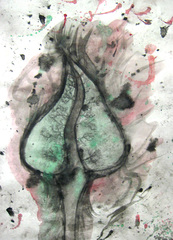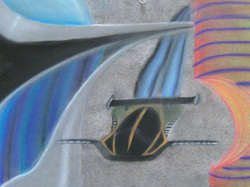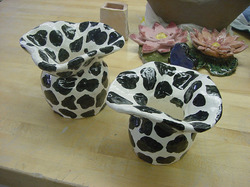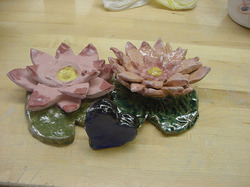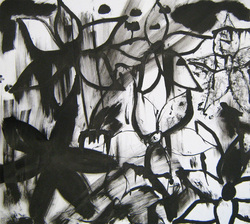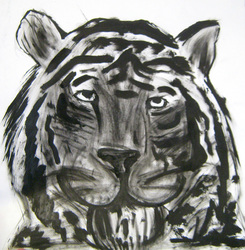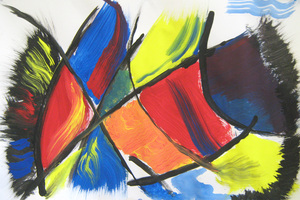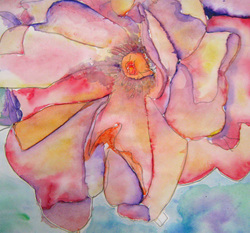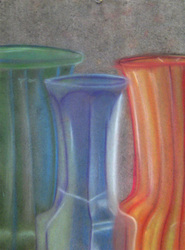Choice-based Art
Imagination and Observation
Creating follows a cyclical pattern that is evidence of a dialogue between the personal intelligences. Students might begin with an idea in their mind and gravitate to materials that can communicate that idea. Or, they might start with concrete manipulation of space and materials, in order to discover their idea. In artistic thinking, students move between the two poles of imagination, which is intrapersonal, and observation, which is interpersonal. They are screening information from the environment that resonants with meaning for them.
The following choice-based student work depicts this cycle and how a few pieces from the same person can show development. It is helpful during instruction to ask the student where their information is coming from themselves (memory) or others (environment including visual references). Pieces are paired vertically in both columns.
In this first drawing, Student 1 used a mirror but relied mostly on memory of what she thought an eye looked like. The form is too symmetrical, eye bulges, lashes and value are stylized.
In this second drawing Student 1 chose to stay with facial features but used pictures of eyes to better proportion shapes and render more subtle values. Bottom eye still bulges a bit as the lower lid should be thicker. Continued close observation is the next step.
Student 2
Student 2 began experimenting with masking tape and paint on a gray ground, after a demo on printmaking. Demos often remind students of past experiences with certain materials and processes. In choice-based art those memories are reinforced building on previous knowledge. The work is abstract shapes and colors created by intersecting lines.
In this piece, Student 2 continues painting but with watercolor on a white ground. The primaries, red, yellow and blue, from the previous work are now mixed to create subtle variations of color in the background. Subject matter is now representational, rather than abstract, and lines are more natural, less angular. The student continues to work with intersecting lines and shapes, but this time increases depth in the picture plane with value.
Student 3
Student 3 experimented with brush and ink washes after a still life demo. He chose a vase with dried weeds from a still life for subject matter. The piece looks like it's in a storm with movement in red washes. The student demonstrates strong lines and shapes with some value, color and texture.
This next piece is one that I will never forget. Student 3 created an imaginative seed pod, rendered in subtle values of red and green, textured with spattered ink. He demonstrated depth in the picture plane by creating a more 3-D form as well as a feeling tone. The viewer is up close to the fragile pod ready to open and release its potential. While in critique with the student, he shared that his girlfriend was pregnant. We both saw the life within the pod as a metaphor of the present and future... I knew he'd be an awesome father.
Student 4
Student 4 began with chalk and imaginative subject matter. A space shuttle was navigating through free-form shapes, angular, curvilinear and textured. He incorporated both warm and cool contrasting colors and created some depth with overlapping. Foreground shapes were dominant and menacing with the dark ship approaching.
Student 5
Student 5 began working with clay making small vases with lips that looked like opening petals. She decided to pattern with black and white shapes repeating the curvilinear vessel form. The student demonstrates contrast with the pattern adding variety to the dominant shape.
Student 5 then decided to create lily pad flowers adding color to the piece. This time the texture was created by repeated petals around the center of two lilies, instead of applied in the glaze pattern. Color was demonstrated through the warm and cool contrasting glazes. She used visual references to construct the flowers and petals.
Student 6
Student 6 experimented with ink and brush washes working from imagination. The flowers forms are abstract and overlapping creating Depth in the picture plane. She pushes shapes and washes of ink off the edges as well. Movement and contrast are demonstrated in the piece.
Student 6 continue with the ink medium but chose a reference of a tiger as her subject matter. Control over the wet medium is demonstrated through the texture and value of the animal portrait. She uses a dry brush technique effectively.
Student 7
Student 7 began her first piece with primary colors in tempera. Black directional lines create movement and a focal area at the intersection of two lines in the middle lower area of the piece. From there feather-like shapes are fanned out and off the left and right sides of the composition.
In her second piece, Student 7 chooses to stay with painting but explores watercolor techniques using visual references. Wet into wet washes create subtle color and value changes within curvilinear shapes. The composition has a focal point, this time in the upper right middle, and petals fan out from the center of the flower. The medium demonstrates development with shape, color and texture.
In the next piece, Student 4 stayed with the medium of chalk and worked from glass vases in a classroom still-life. Close observation of actual 3-dimensional space improved overlapping to create depth. The subtle warm and cool changes in color demonstrated value and transparency in the vases. The student also introduced white to show reflections in the glass. These skills translate into imaginative schemas that have greater detail and accuracy.
CHECK BLOG FOR UPDATES ON NEW STUDENT WORK!
